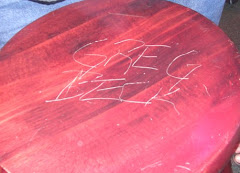Supercool Supernova

(click pics to superembiggen)
A supernova is what happens when a massive dying star breathes its last gasp of nuclear fusion and bequeaths its long hoarded treasures to its offspring...you and me.
Astronomer Alicia Soderberg (who is also an incredible hottie)

at Princeton had the rare good fortune to catch a supernova in the act of exploding. This has never, ever been seen before.
I found out about this remarkable discovery through a twitter from Phil Plait (NOT a hottie)

over at Bad Astronomy.
He, being an actual astronomer can explain the details far better than me (a lowly astrowanker).
"The Quick Version
NGC 2770 is a galaxy at the relatively close distance of 84 million light years away. On January 9, 2008, a massive star in it exploded, and instead of finding out days or weeks later, astronomers caught it in the act, right at the moment, in flagrante delicto. The image above, from the Gemini observatory, shows the galaxy and its new supernova.
We’ve seen lots of stars explode; thousands in fact. But because of the mechanics of how a star actually explodes, by the time we notice the light getting brighter, the explosion may be hours or even days old. This time, because it was caught so early, astronomers will learn a whole passel of new knowledge about supernovae.
That’s the brief summary…"
But the details are far more fascinating, if you have the patience for a deeper dive.
"The Death of a Star
I’ve explained before how massive stars explode. After a few million years of generating energy by fusing light elements into heavier ones (hydrogen to helium, helium to carbon, and so on), the core runs out of fuel. Iron builds up in the very center of the star, and no star in the Universe has what it takes to fuse iron. It’s like ash piling up in a fireplace. At some point, so much iron builds up that it cannot support its own weight, and the ball of iron collapses.
In a millisecond, more than the mass of the Sun’s worth of iron collapses from an object the size of the Earth to a ball only about 20 kilometers across. Weirdly, it happens so quickly that the surrounding layers don’t have time to react, to fall down (think Wile E. Coyote running over a cliff’s edge). While they hesitate and just start to fall, all hell breaks loose below them.
[youtube clip inserted by me - xo]
The collapse of the core generates a vast explosion, a shock wave of incomprehensible power that moves out from the surface of the collapsed core into the layers of gas still surrounding it. Like a tsunami of energy, this shock wave works its way up to the surface of the star. The energy is so huge that the material it slams into gets heated to millions of degrees. When the shock wave breaks out through the surface, it bellows its freedom to the Universe with a flash of X-rays, a brief but incredibly brilliant release of high-energy light.
After that flash (what’s called the shock breakout), the explosion truly begins. The outer layers of the star — gas that can have many times the mass of the Sun, octillions of tons — blast outwards. The star tears itself apart, and becomes a supernova.
The Importance
You should understand something else here, too. As the blast wave moves through the gas of the star, the elements in that gas undergo an explosive fusion, creating new, heavier elements. Elements like iron, calcium, and gold. The hemoglobin in your blood, the bones in your body, and the wedding ring on your finger — all of these can trace their lineage back to a star that exploded like SN2008D. Every heavy element in the Universe was created in such an event, in the heart and fury of a supernova.
We owe our very existence to stars that explode."
As Carl Sagan, the smartest stoner to ever draw a paycheck would say, we are all stardust. Wow!
So twist up a spliff, fire up the bong, crank up some Pink Floyd, and watch 10 minutes of Cool Carl zoning out about neutron stars, pulsars and black holes.
Take away quote from Sagan: "I've been to a couple of parties like that myself."




























1 comment:
First!
You are such an astronerd!
Post a Comment